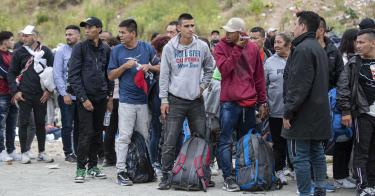Amid all the confusion at our border, at least one question with national security and public safety implications has gone almost entirely unexamined: We’re told that those who enter our country illegally are “vetted” before they’re released into our communities, but what does this mean?
Not much. Since President Joe Biden took office, the Department of Homeland Security has released an estimated 2 million migrants into the U.S. after minimal “processing.” This means taking their photos and fingerprints, entering (unverifiable) names and birth dates, running this data through U.S. law enforcement and immigration databases, and creating an immigration file if a prior one isn’t found.
Some of those who are released get a “notice to appear” at a future immigration court hearing to argue why they shouldn’t be removed from the U.S. for being here illegally. But when overwhelmed, DHS has simply released them with a “notice to report” to their nearest Immigration and Customs Enforcement (ICE) office, where they can later get the “notice to appear” and start that slow legal ball rolling. In a small number of cases, ICE tracks them or asks them to check in via phone every so often.
As for “vetting,” in immigration terms it should mean making sure each unknown migrant isn’t a known terrorist, and doesn't have a criminal record, contagious disease, or prior immigration violation. This is important, since those currently being released will be our neighbors for a long time, given immigration court and USCIS backlogs.
>>> Secure America’s Borders and Reduce Crime
However, DHS agents can only check crime and terrorism databases from the U.S. or some allies. That doesn’t include most of the countries the current wave is coming from. There aren’t many Canadians walking across the Rio Grande, but plenty of Russians and Chinese are.
In the most recent border rush, DHS released hundreds of migrants into Yuma, Arizona. Yuma Mayor Douglas Nicholls claimed that the migrants “have been vetted” and so “there’s not people that are convicted of crimes that are being released.” If that's what DHS told him, it’s not true.
Nicholls said that the released migrants “have been vetted at least to the point where Border Patrol has issued them notice to appear papers wherever they end up living in the country,” according to the Daily Mail. He understands that those papers will begin an immigration process that will take many years before the migrant is either given asylum or (in most cases) ordered removed from the U.S.
At current rates, the chances of ICE enforcing that order is negligible. In the meantime, we get to find out more about who they all are.
Even assuming that the rate of felony convictions among the released population is similar to the U.S. national average, then we’re letting in hundreds of convicts a month. But anyone can observe that a high percentage of those being caught and released at the border are young men, whose rate of criminal behavior is above average among demographics everywhere.
Thanks to the 2 million migrants recently released, plus a couple million more “gotaways,” Americans must now live with thousands of unknown criminals with a significant chance of re-offending.
For example, ICE “removed a foreign fugitive wanted in Venezuela for murder” from St. Paul, Minnesota. They called this man, Daniel Alberto Arape Teran, an “unlawfully present noncitizen,” but that euphemism doesn’t change the fact that he’s bad news.
Teran was arrested in May 2022 after entering the U.S. illegally at Eagle Pass, Texas (where I visited last October). After this initial “encounter,” the Border Patrol would have “processed” him as I described above. If Teran’s face, fingers, or name had no match against U.S. criminal and terrorism databases, DHS would have considered him “vetted.”
>>> “Alternatives to Detention” for Illegal Aliens: Effective with Mandatory Tracking for Entire Process
Having technically placed him into removal proceedings under the Immigration and Nationality Act, DHS probably gave Terana “notice to appear” in court, probably years in the future, and just let this murder suspect roam free in America until Dec. 13, when they re-arrested him pending deportation.
How ICE found out that Teran was wanted in Venezuela is hard to say, but remember, this was a murder suspect. Don’t expect them to put that level of effort into every burglar, rapist, and drunk driver they’ve let in under orders from Secretary of Homeland Security Alejandro Mayorkas.
Now multiply Teran’s case by thousands more, from nearly every country on Earth. We don’t share criminal records with most countries, and many of the poorest lack digital, searchable records anyway.
Imagine if only 5% of Biden’s released migrants have criminal records we aren’t able to discover through “vetting” before releasing them. Whether they will re-offend, and who will be hurt, will be revealed, victim by victim, over the coming decades.
This piece originally appeared in MSN.com




